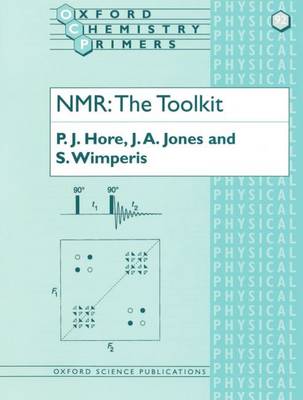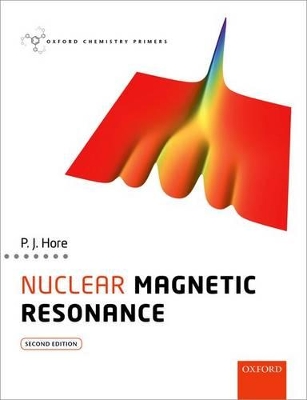Oxford Chemistry Primers
1 primary work • 3 total works
Book 92
This book provides a concise, approachable description of how modern NMR experiments work, aimed principally at those who use, or might use, an NMR spectrometer and are curious about why the spectra look the way they do. It provides, in an accessible and relatively informal fashion, the conceptual and theoretical tools needed to understand the inner workings of some of the most important multi-pulse, multi-nuclear, multi-dimensional techniques that chemists and biochemists use to probe the structures and dynamics of molecules in liquids. Part A (chapters 1-6) starts with the vector model, and proceeds to the more powerful product operator formalism. Part B (chapters 7-10) shows how straightforward quantum mechanics can be used to understand NMR and product operators at a more fundamental level. The treatment builds on material in P.J. Hore's OCP 32, Nuclear Magnetic Resonance, but it can also be used as a stand-alone text.
The renowned Oxford Chemistry Primer series, which provides focused introductions to a range of important topics in chemistry, has been refreshed and updated to suit the needs of today's students, lecturers, and postgraduate researchers. The rigorous, yet accessible, treatment of each subject area is ideal for those wanting a primer in a given topic to prepare them for more advanced study or research. Moreover, cutting-edge examples and applications throughout the texts show the relevance of the chemistry being described to current research and industry.
The learning features provided, including questions at the end of every chapter and online multiple-choice questions, encourage active learning and promote understanding. Furthermore, frequent diagrams, margin notes, further reading, and glossary definitions all help to enhance a student's understanding of these essential areas of chemistry.
NMR: The Toolkit describes succinctly the range of NMR techniques commonly used in modern research to probe the structures and properties of molecules in liquids. Emphasis is placed throughout on how these experiments actually work, giving a unique perspective on this powerful experimental tool.
Online Resource Centre
The Online Resource Centre to accompany NMR The Toolkit: How Pulse Sequences Work features:
For registered adopters of the text:
· Figures from the book available to download
For students:
· Full worked solutions to the end-of-chapter exercises
The learning features provided, including questions at the end of every chapter and online multiple-choice questions, encourage active learning and promote understanding. Furthermore, frequent diagrams, margin notes, further reading, and glossary definitions all help to enhance a student's understanding of these essential areas of chemistry.
NMR: The Toolkit describes succinctly the range of NMR techniques commonly used in modern research to probe the structures and properties of molecules in liquids. Emphasis is placed throughout on how these experiments actually work, giving a unique perspective on this powerful experimental tool.
Online Resource Centre
The Online Resource Centre to accompany NMR The Toolkit: How Pulse Sequences Work features:
For registered adopters of the text:
· Figures from the book available to download
For students:
· Full worked solutions to the end-of-chapter exercises
The renowned Oxford Chemistry Primers series, which provides focused introductions to a range of important topics in chemistry, has been refreshed and updated to suit the needs of today's students, lecturers, and postgraduate researchers. The rigorous, yet accessible, treatment of each subject area is ideal for those wanting a primer in a given topic to prepare them for more advanced study or research. Moreover, cutting-edge examples and applications throughout the texts show the relevance of the chemistry being described to current research and industry.
The learning features provided, including questions at the end of every chapter and online multiple-choice questions, encourage active learning and promote understanding. Furthermore, frequent diagrams, margin notes, and glossary definitions all help to enhance a student's understanding of these essential areas of chemistry.
Nuclear Magnetic Resonance offers a concise and accessible introduction to the physical principles of liquid-state NMR, a powerful technique for probing molecular structures. Examples, applications, and exercises are provided throughout to enable beginning undergraduates to get to grips with this important analytical technique.
Online Resource Centre
The Online Resource Centre to accompany Nuclear Magnetic Resonance features:
For registered adopters of the text:
· Figures from the book available to download
For students:
· Multiple-choice questions for self-directed learning
· Full worked solutions to the end-of-chapter exercises
The learning features provided, including questions at the end of every chapter and online multiple-choice questions, encourage active learning and promote understanding. Furthermore, frequent diagrams, margin notes, and glossary definitions all help to enhance a student's understanding of these essential areas of chemistry.
Nuclear Magnetic Resonance offers a concise and accessible introduction to the physical principles of liquid-state NMR, a powerful technique for probing molecular structures. Examples, applications, and exercises are provided throughout to enable beginning undergraduates to get to grips with this important analytical technique.
Online Resource Centre
The Online Resource Centre to accompany Nuclear Magnetic Resonance features:
For registered adopters of the text:
· Figures from the book available to download
For students:
· Multiple-choice questions for self-directed learning
· Full worked solutions to the end-of-chapter exercises


